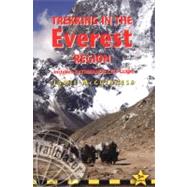
| Introduction | |
| Planning Your Trek | |
| What is trekking? Trekking in the Khumbu, With a group or on your own? (Independent teahouse trekking, Commercial guided treks, Nepali trekking agencies, Trekking agencies outside Nepal (UK and Ireland, Continental Europe, USA, Canada, Australia, New Zealand) How long to go for, Route options (Walking in or out, Flying in, Route options above Namche, Leaving the region, Other options, Other activities), Budgeting, When to go, What to take (Factors affecting equipment selection, Equipment list, Renting or buying equipment in Nepal, Adventure trekking equipment, Recommended reading, Map recommendations), Health precautions and inoculations (Specific age groups, Medical conditions, Inoculations, Medical insurance | |
| Nepal | |
| Facts about the country (Geographical background, Climate, Historical outline, Economy, Development), Practical information for the visitor (Visa and trekking regulations, Getting to Nepal, Local transport, Language, Electricity, Time, Money, Post and telecommunications, TV, radio, newspapers and magazines, Holidays and festivals, Food, Drink, Things to buy, Security | |
| Kathmandu | |
| The city (History, Arrival and departure, Orientation, Where to stay, Where to eat, Nightlife, Services, Transport, What to see, Sightseeing tours), Trek preparation in Kathmandu (Trekking equipment, Organizing a guided trek in Kathmandu, Hiring guides and porters, Money for the trek, Luggage storage, Getting to the Khumbu | |
| The Everest Region | |
| Mountaineering history (Everest, Cho Oyu, Makalu, Lhotse), The people, The Sherpas (Origins, Agriculture, Diet, The Sherpa house, The Sherpa view of life, Mountaineers, sirdars and porters, Coping with development), The Rai (Origins, Religion, Agriculture and work, Values), National parks (Sagarmatha National Park, Makalu-Barun National Park and Conservation Area (MBNPCA), Facilities for the trekker (Accommodation and food, Shops, banks and post offices), Minimum impact trekking (Environmental concerns, Cultural considerations, Economic impact) | |
| Route Guide and Maps | |
| Using this guide (Route descriptions, Village and feature names, Trail maps, Following trails, Walking times, Altitudes, Facilities, Map key), Jiri to Namche (Introduction, Kathmandu to Jiri, Jiri, Jiri to Shivalaya, Shivalaya to Bhandar, Bhandar to Junbesi, Junbesi, Junbesi to Bupsa, Bupsa to Surke/Lukla/Namche), Trekking from Lukla (Introduction, Lukla, Lukla to Namche, Namche, Around Namche, Namche to Thame, To Lobuche and Kala Pattar, Namche to Tengboche, Tengboche, Tengboche to Pheriche/Dingboche, To and around Chukhung, Pheriche/Dingboche to Lobuche, Lobuche to Gorak Shep and Kala Pattar, Heading down), To Gokyo (Introduction, Namche to Gokyo, Gokyo and around, To and from Phortse, Chugyima La, Chugyima La to Gokyo), Khumbu side trips and pass-hopping (Khumbu to Makalu, Kongma La, Peak, Amphu Labtsa, Mingbo Valley, The Bhote Valley, Kyajo, Phaplu start, To Chialsa) Salpa-Arun to the Khumbu (Introduction, Getting to eastern Nepal, Basantpur to Tumlingtar, Hille Leguwa to Tumlingtar, Tumlingtar, Tumlingtar to Balawa Besi, Balawa Besi to Jau Bari, Jau Bari to Sanam, Sanam to Najing Dingma, Gai Kharka to Puiyan) From Bhojpur (Bhojpur, Bhojpur to Dingla, Dingla), Rolwaling (Introduction, The Rolwaling Valley, Simigoan to Dolakha/Charikot, Gongar to Barabise), Trekking peaks (Preparation, Imjatse/Island Peak, Mera, Lobuche, Parcharmo, Pokalde/Dolma Ri, Other trekking peaks in the region) | |
| (6) Appendices | |
| Itineraries and acclimatization planner, | |
| Health, | |
| Flora and fauna, | |
| Nepali words and phrases, | |
| Glossary, | |
| Bibliography, | |
| (7) Index | |
| Table of Contents provided by Publisher. All Rights Reserved. |
The New copy of this book will include any supplemental materials advertised. Please check the title of the book to determine if it should include any access cards, study guides, lab manuals, CDs, etc.
The Used, Rental and eBook copies of this book are not guaranteed to include any supplemental materials. Typically, only the book itself is included. This is true even if the title states it includes any access cards, study guides, lab manuals, CDs, etc.
Excerpted from Trekking in the Everest Region, 5th Edition: Includes Kathmandu City Guide, Nepal Trekking Guides by Jamie McGuinness
All rights reserved by the original copyright owners. Excerpts are provided for display purposes only and may not be reproduced, reprinted or distributed without the written permission of the publisher.